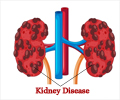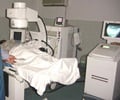Researchers at Children's Hospital Boston were able to block the formation of fluid-filled cysts, the hallmark of polycystic kidney disease in a mouse model.

PKD is the most common fatal genetic disease affecting Caucasians in the U.S. Currently, there is no approved treatment to halt cyst growth, which causes a gradual but relentless loss of kidney function. Patients must often go on chronic dialysis by mid-adulthood or wait for a kidney transplant.
"This study gives us a new therapeutic target in PKD," says Jordan Kreidberg, PhD, in Children's Division of Nephrology, the study's senior investigator. "If we can get more supportive data in mice, it may provide the basis for a clinical trial in humans."
Hopes were raised when animal models showed promise in drugs inhibiting mTOR, a protein that coordinates cell growth and proliferation and has been shown to be hyper-activated in the disease. However, the reasons for this hyper-activation aren't well understood, and much-anticipated clinical trials of mTOR inhibitors, published August 26 in the New England Journal of Medicine, showed little or no effect on cyst growth, in part because toxicity limited their dosing.
The new study, led by Kreidberg and first author Shan Qin, MD, PhD, took a closer look at the molecular pathways, and showed that mTOR hyper-activation results from unwanted activity of c-Met, the receptor for hepatocyte growth factor.
Kreidberg and Qin used a mouse model for PKD created by collaborators at Brigham and Women's Hospital, in which the PKD1 gene (mutated in 85 percent of PKD patients) is deleted. When they blocked c-Met activity in mouse embryonic kidneys, using a small molecule called 448101 Met Kinase Inhibitor, also known as SU11274 (Calbiochem, La Jolla, Calif.), cyst formation was reduced to the level seen in normal kidneys.
Advertisement
"Recent studies on the biology of cyst formation have offered the hope for possible treatments that can either prevent or retard progression of cysts in patients with CKD, but the first clinical trial did not work," says William Harmon, MD, director of Pediatric Nephrology at Children's. "Dr. Kreidberg's discoveries are very promising in suggesting exciting new approaches to treating a very serious disease."
Advertisement
"PKD is quite complex, with several regulatory pathways involved, and multiple places to target with therapy," he says. "It will likely benefit from sub-toxic doses of multiple agents, similar to cancer chemotherapy."
c-Met inhibitors are more specific and limited in their action than mTOR inhibitors, so may be less toxic, Kreidberg adds. "There are many ongoing cancer trials with c-Met inhibitors, so there's going be increasing information on their safety and pharmacology that might help us translate this to a treatment for PKD."
Aside from its role in cancer, c-Met is essential for embryonic development and wound healing. Normally, after it's been activated, it is tagged for degradation. But Kreidberg and colleagues show that in PKD, c-Met is never tagged, because the molecule that does the tagging get trapped inside a structure in the cell known as the Golgi apparatus.
The findings are consistent with the observation of excess amounts of c-Met in the cells lining the kidney cysts of PKD patients. "c-Met is probably part of a development pathway that's turned on again, sometime in early or mid-adulthood," says Kreidberg.
Polycystic kidney disease, the fourth leading cause of kidney failure, affects more than 700,000 people in the U.S., far surpassing other genetic disorders such as cystic fibrosis and sickle-cell disease.
Source-Eurekalert















